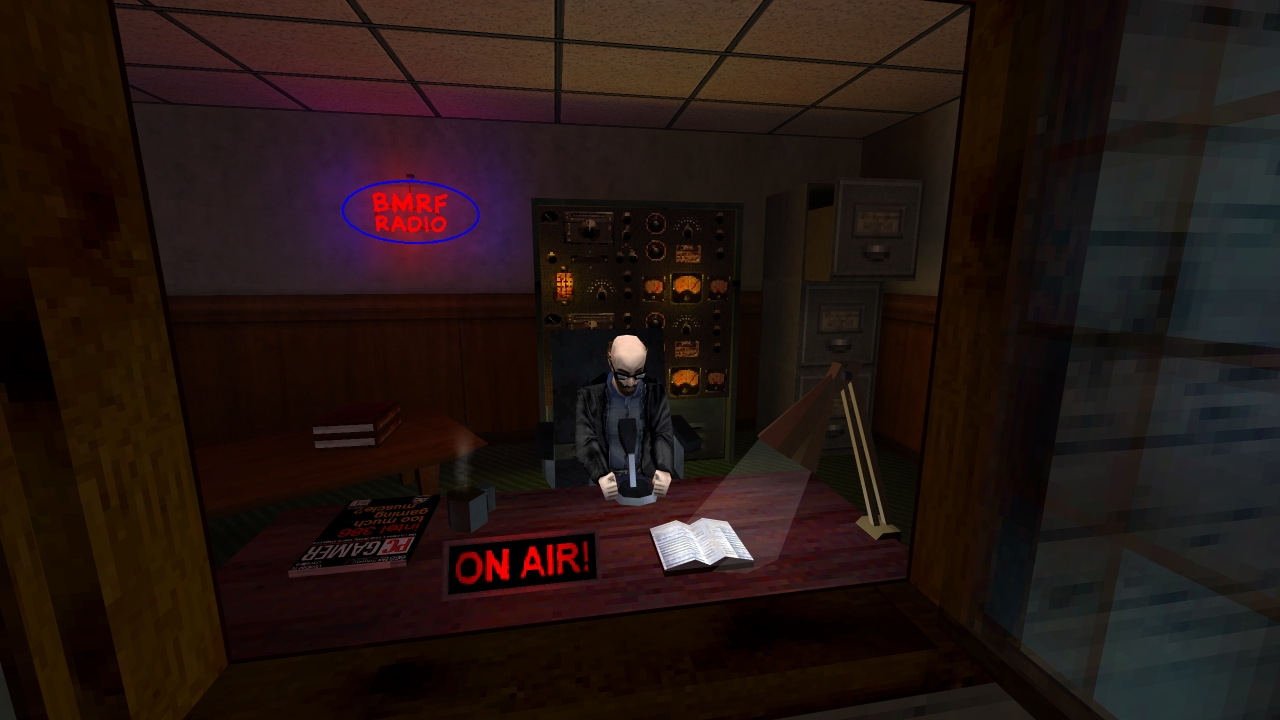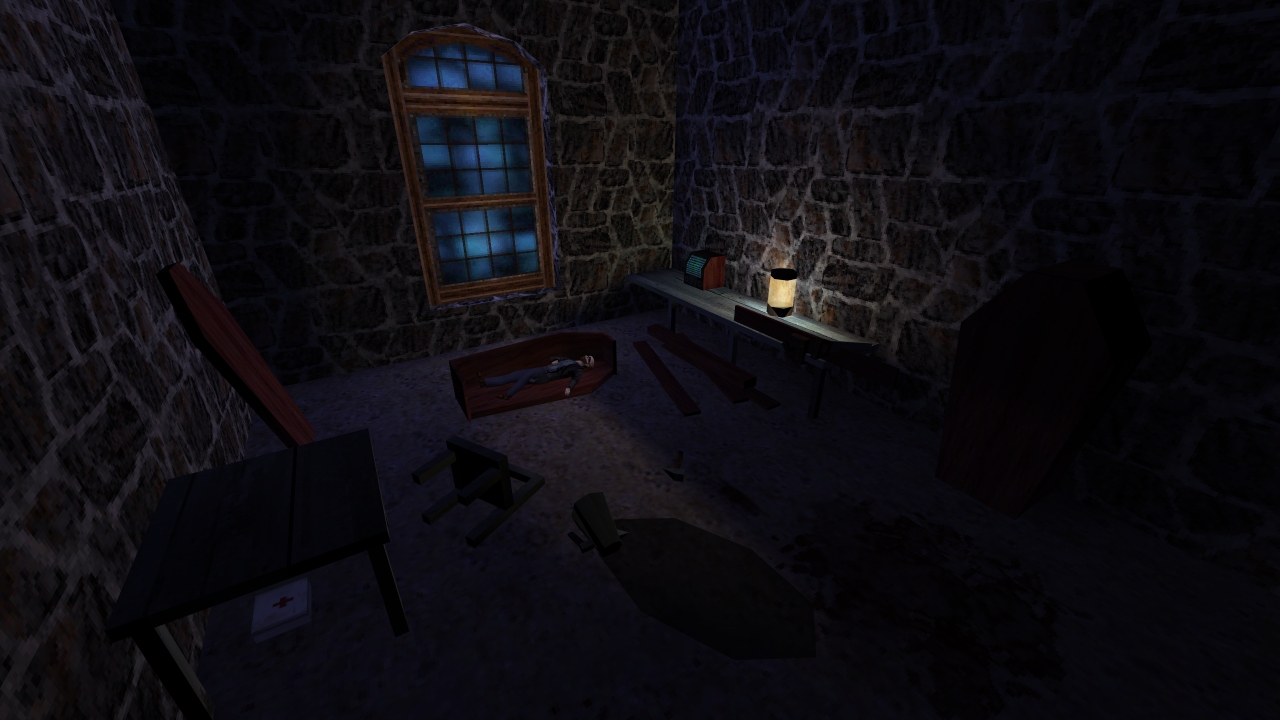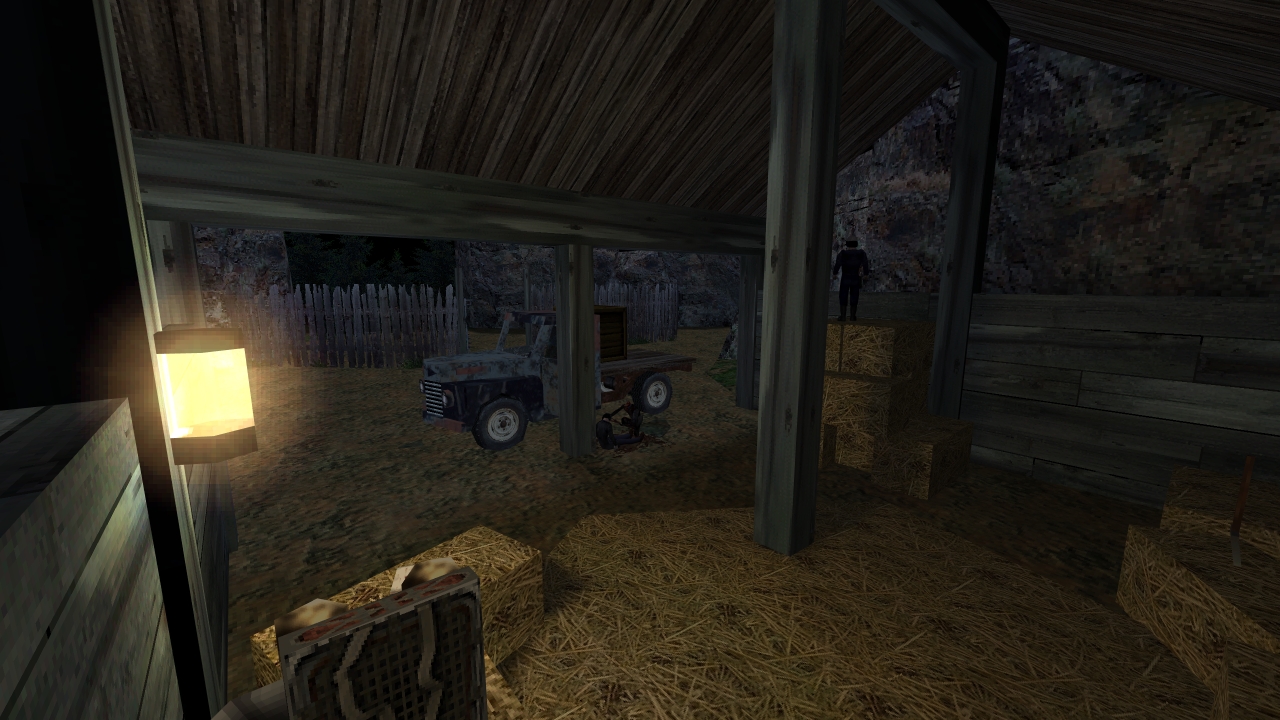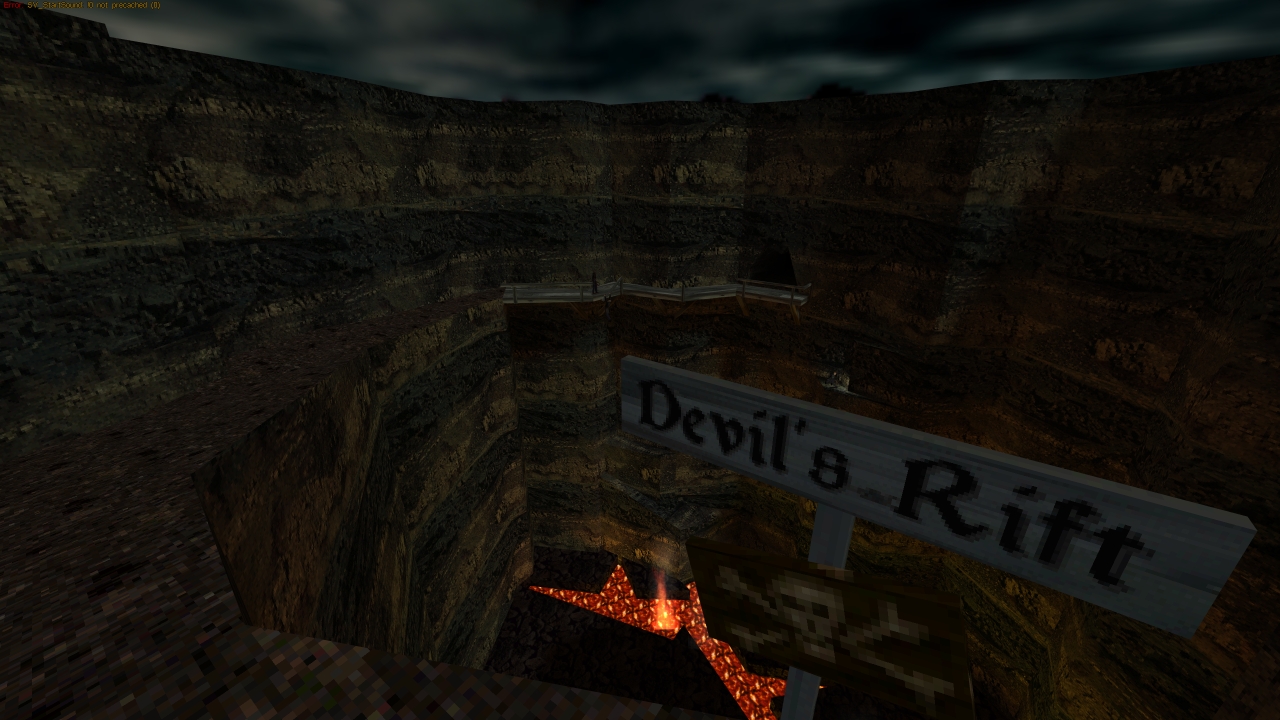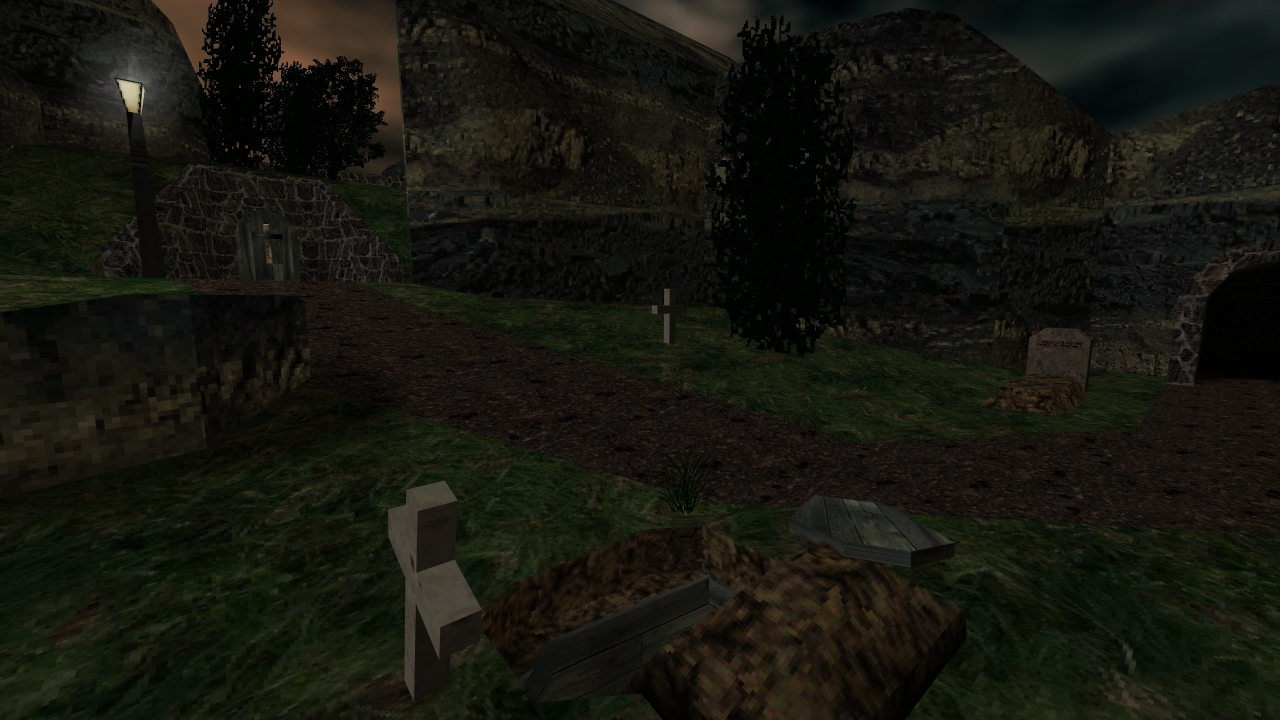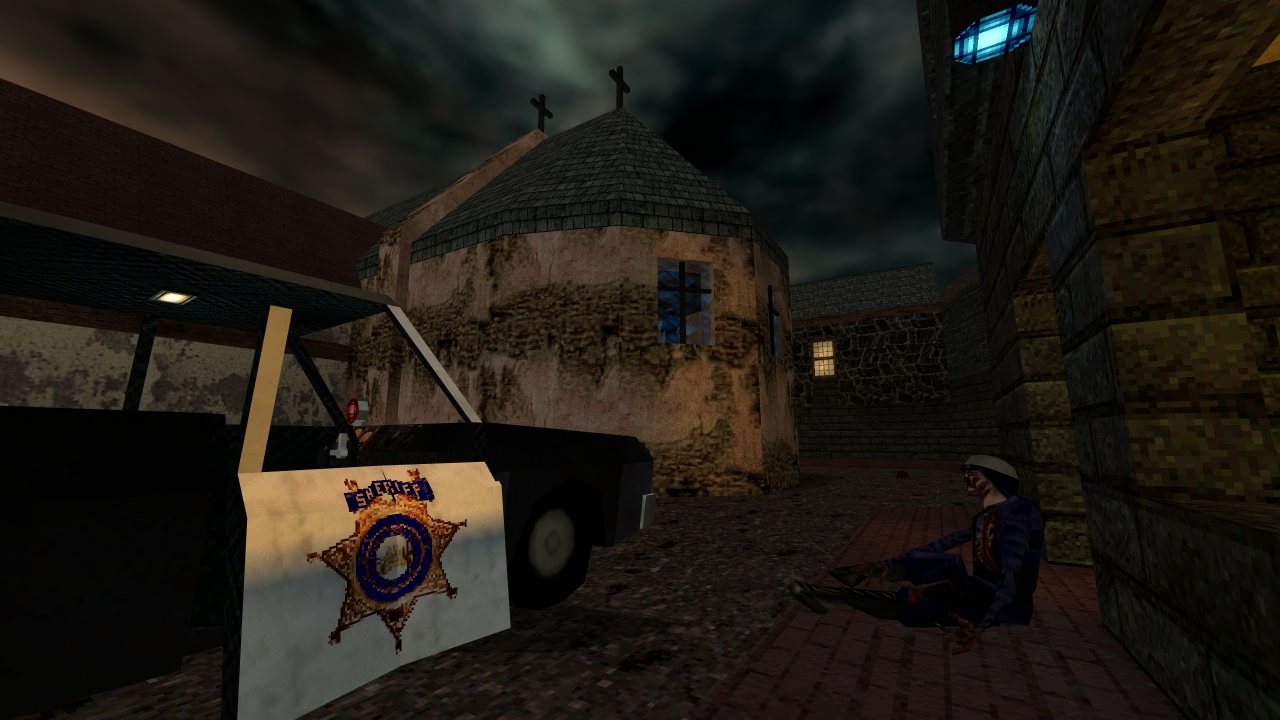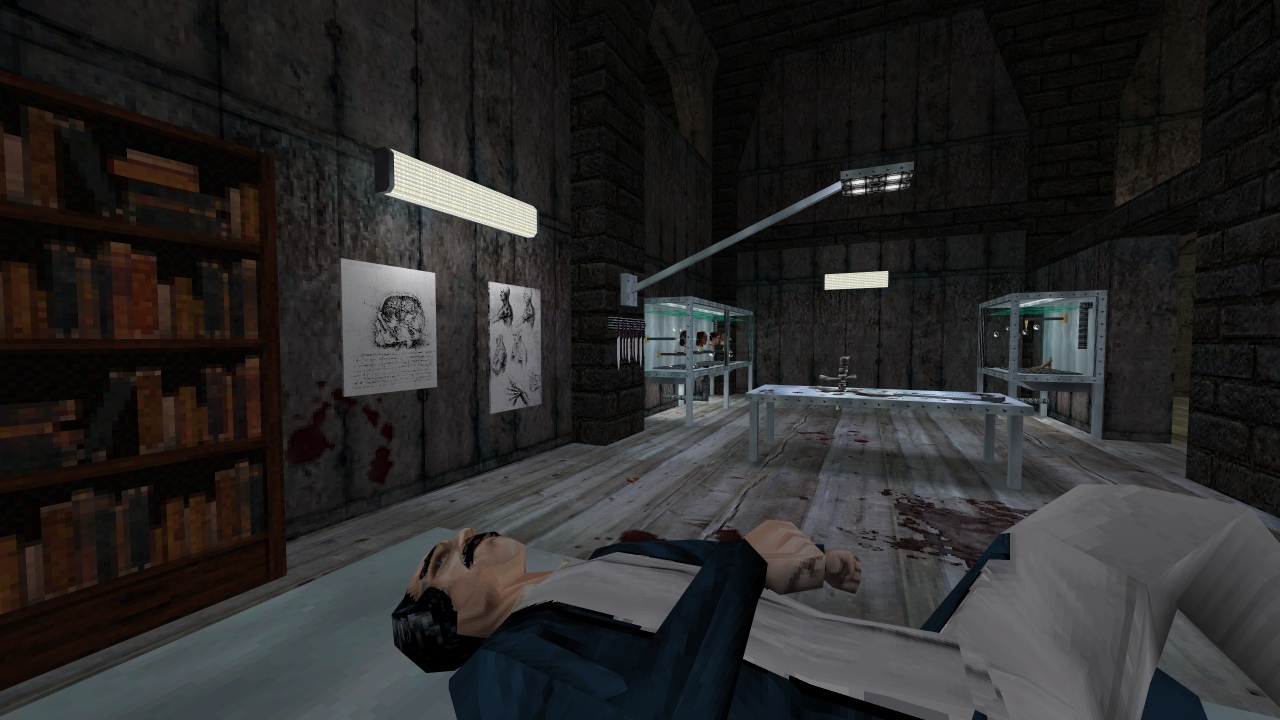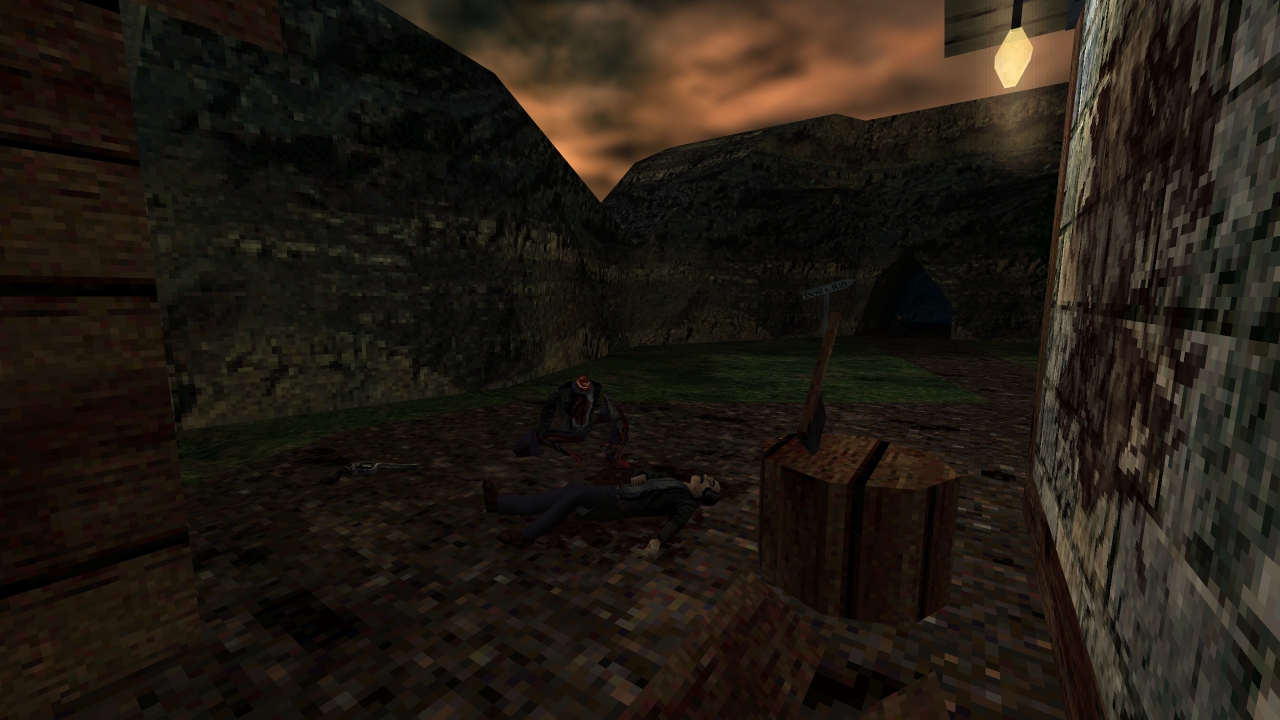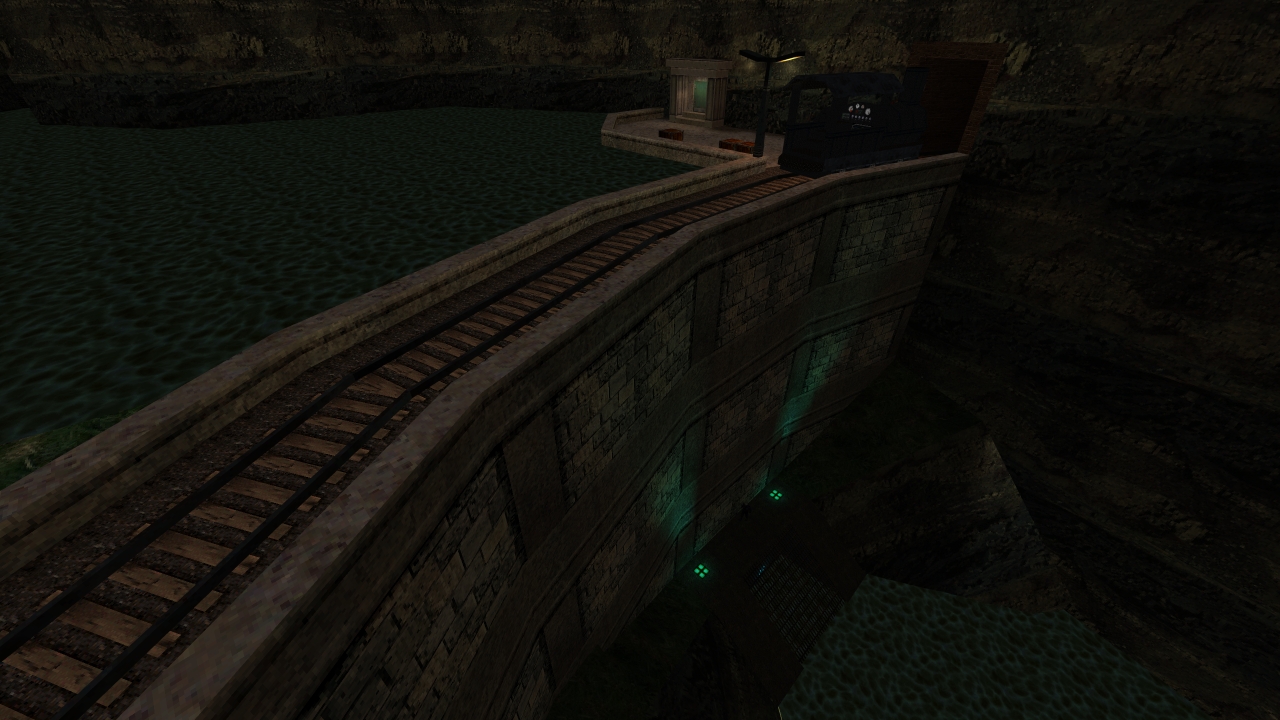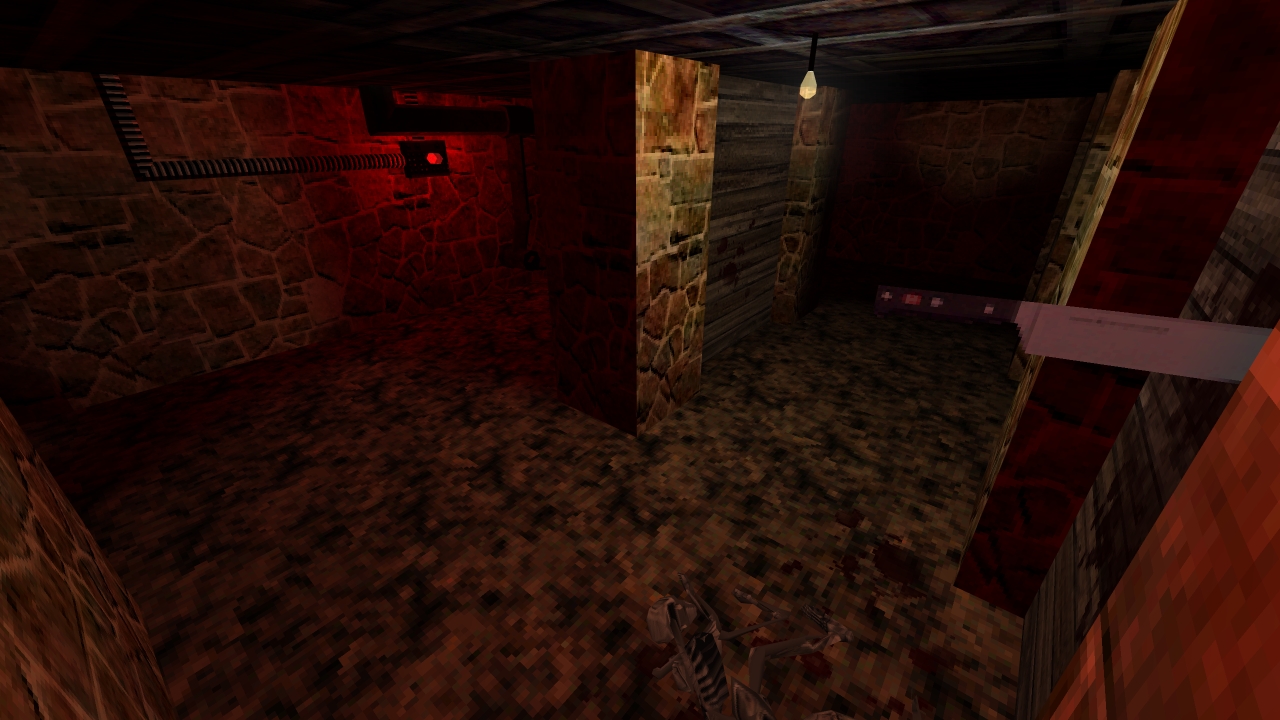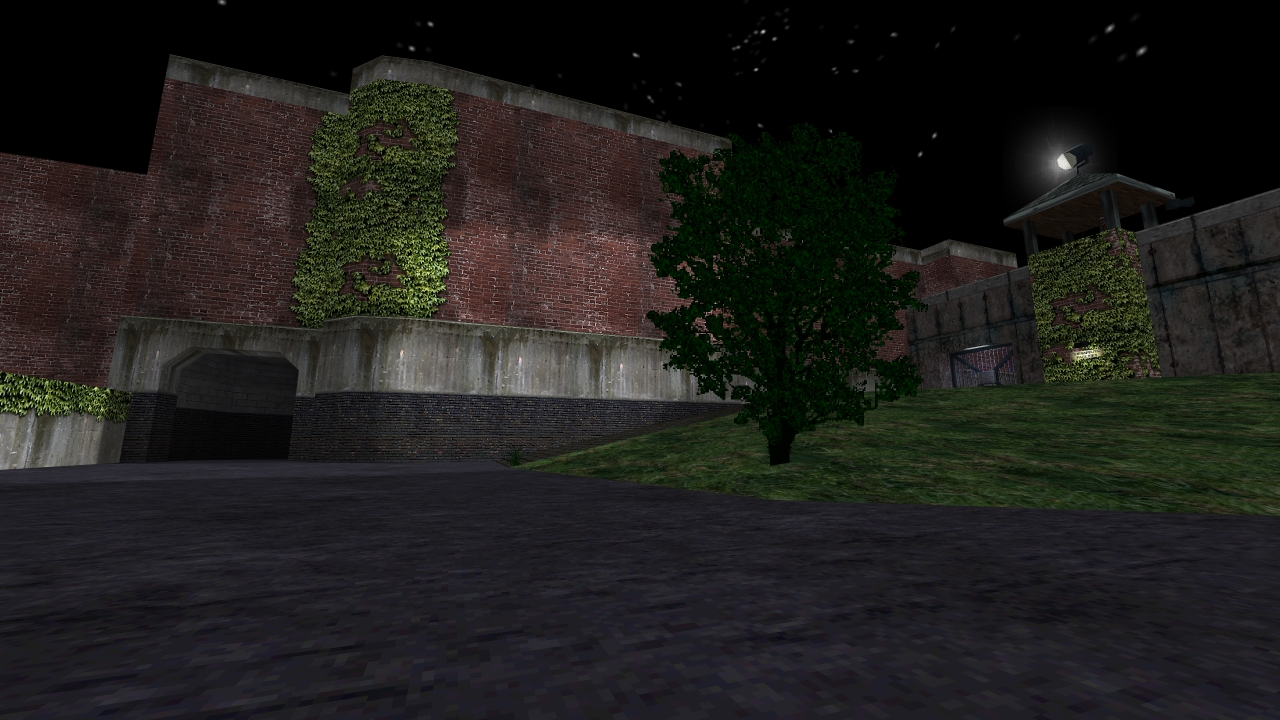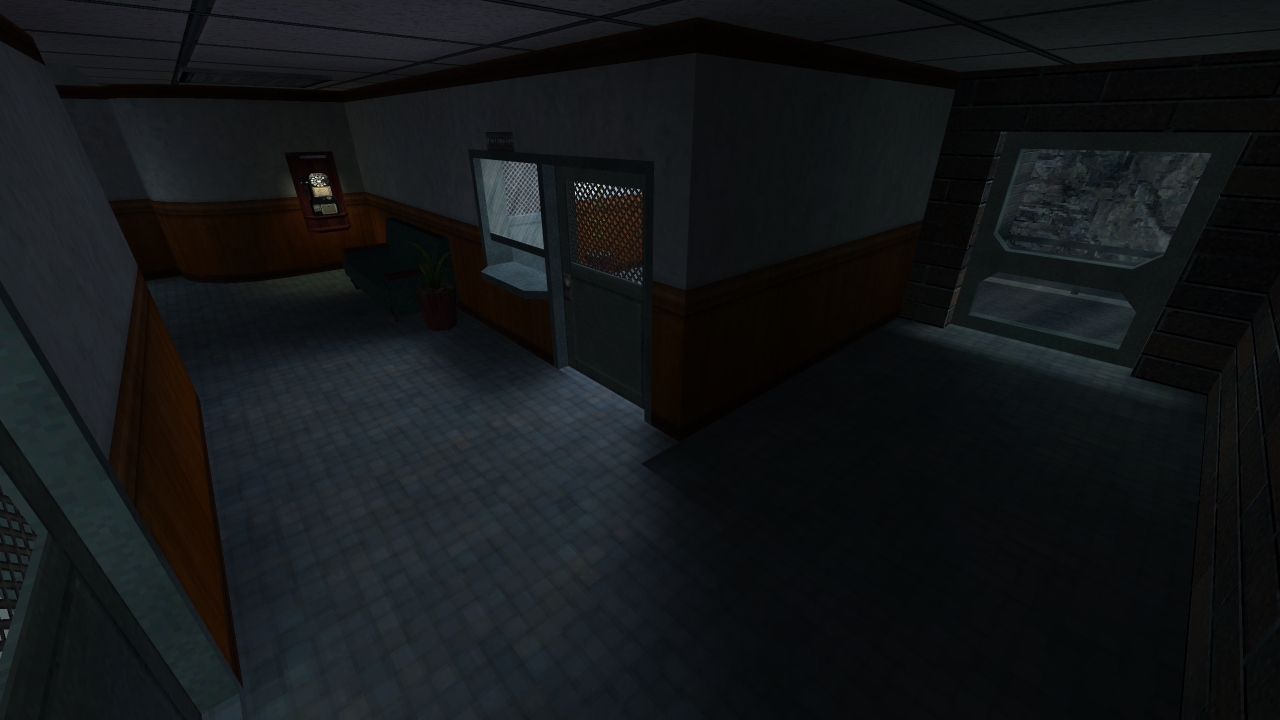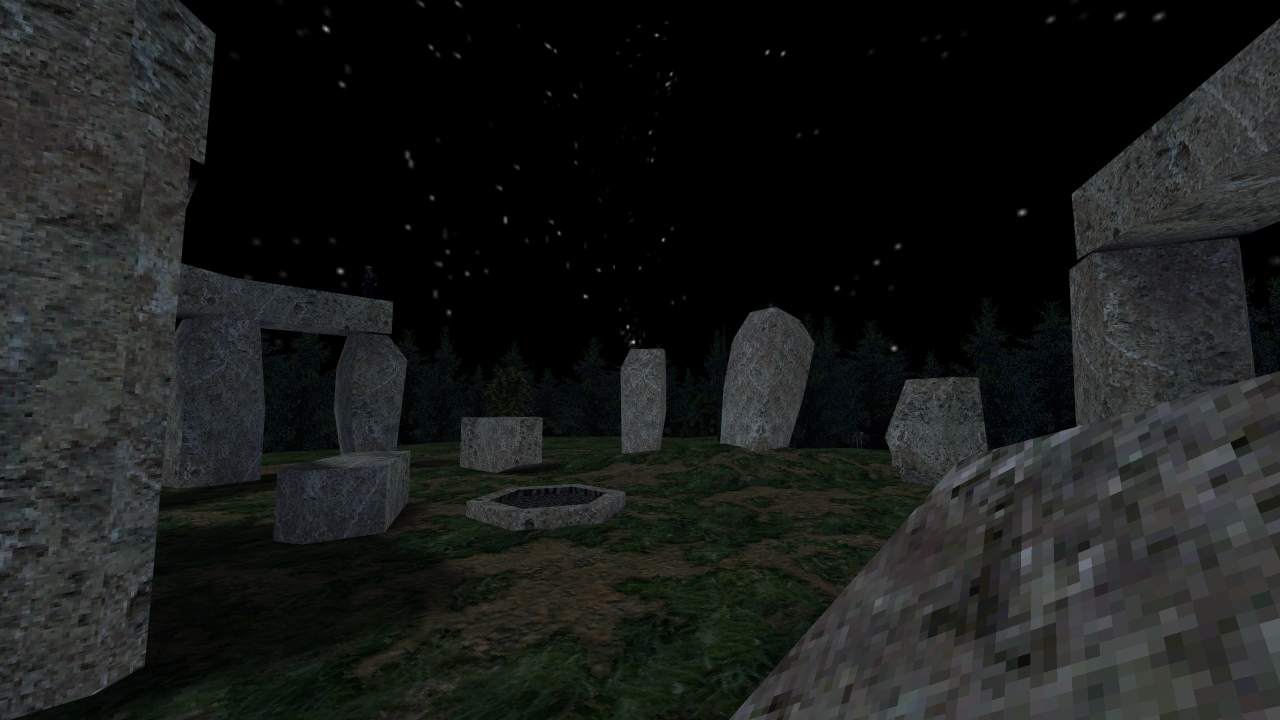Introduction
You take on the role of a successful writer who is struggling to complete their latest work. In an effort to regain inspiration your publisher rents out a country house to relax and write with renewed invigoration. During the long drive a hurried radio announcement talks about an unknown atmospheric phenomena reported around the area. Just after broadcasting this warning, a fierce lightning bolt strikes and causes you to swerve into the river.
I decided a re-review was in order after replaying They Hunger. The old review has been archived here.
Review
Considered as a cult classic amongst the repository of Half Life mods that caught a lot of attention back while it was new and was crafted by a well received Quake mapper known for works such as Monastry and The Slaughterhouse. They Hunger was a promotional mod produced for PCGamer to be included as a bonus in their magazine with the next sequential episodes being released a year apart from each other. The experience itself steers far away from your typical Black Mesa settings and instead leans closer toward a classic pulp horror scenario using occult and supernatural themes. Set in 1950s America around a quiet secluded town of Rivendale and its surrounding countryside involving a strange case of the dead raising from their graves and attacking civilians.
The first episode starts off with an effective introduction once players take control after their roadside accident right up until the initial zombie infestation reveal during which an ever present, eerie calmness permeates this short exploration phase. Swimming through a drainage duct gives access to an old catacomb system, stretches of dark halls with several bricked up alcoves lining its walls. Certain tombs crack at the seams while a recent addition is currently in progress, tools suddenly abandoned beside a blood stained floor. Further ahead lies an exit leading back outside where a trail of graves lead their way up to a small mausoleum where civilians may reside. Yet upon entering it becomes evident that no living person is around to provide aid. Just a dying man’s last words, a sturdy umbrella beside him and the cries of undead as they crawl out from their resting spots.
Going forward from here players will be taking a long journey across its 56 individual levels visiting several key landmarks and making many detours in a constant push to reach specific milestones before concluding that particular episode. Besides an obvious desire to stay alive, these goals will range from reaching a local police station to seek help; gaining access to an asylum to learn of its secrets; or retracing familiar grounds in an effort to put an end to this madness. As a staple to typical Half Life formula, getting around is never as simple as it should be and will always inevitably involve stopping by other places to grab supplies and finding an alternative path, because the shortest route forward is likely barricaded off by something like a collapsed tunnel or burning wreck. This in turn guarantees many sites to visit and there is plenty to see. During the first episode alone players will wade through a murky swamp, get scorched alive within the volcanic depths of Devil’s Rift, hijacking a train ride to take a scenic route across the dam and perhaps grabbing a cold one at Rivendale’s local pub should the denizens allow it. There will always be memorable moments somewhere during any of these three acts.
Unfortunately the intended means of progressing forward wasn’t always immediately clear what was expected from players for all campaigns due to a lack of clearly define goal posts in certain situations. Paths themselves may be obscured from sight or located in a niche corner, not an unusual situation for underwater routes. Other times I’m either brushing up against multiple locked doors hoping one will lead me somewhere new or questioning if an event hadn’t been triggered properly. The asylum itself while large and sprawling is guilty due to its many shortcuts looping back to previous areas and possibly getting lost. One particular example that stands out occurred immediately after escaping a jail cell where I continued down the nearest tunnel expecting my companion in arms to unlock and open a large gate for me. But nothing happened. It wasn’t made obvious enough I should be returning to the police station despite that very same back entrance was locked moments prior with no indication its status had changed at any point.
In regards to enemy selection, zombies do indeed make up for a majority of encounters across the whole campaign and become a defining threat as they stop at nothing to satiate their craving for fresh meat. It didn’t seem to matter how many undead I would take down as their ranks would soon be replaced as if endless in numbers. Just as I thought to be out of danger something else would often be skulking close behind from the very route I arrived from. Cleared paths never remained safe forcing me to stay moving to avoid being surrounded while trekking across the countryside. Their sheer prominence might be alarming in terms of gameplay monotony as zombies may not make for the most enjoyable combat scenarios, but choosing when to fight or take flight instead is a key component for They Hunger and whether that will make this journey more memorable or fall into tedium as a result. The basic pistol with an attached silencer therefore became my personal go to firearm against many foes, great for taking out fodder in a snap and even accurate for distant targets. By comparison the shotgun just felt too slow for what it achieves, better reserved for beefier, singular targets. A flamethrower acquired much later is absolutely perfect against swarms, or any explosives available on hand for that matter.
Enemy diversity does ramp up frequently early on, from cosmetic differences for zombies to entirely new roles based on existing Half Life variants with minor changes made to them. Wolves as one example behave and animate much like their Hound Eye counterpart, just without their discharge attack, instead rushing down players making use of those sharp fangs. Enemy placement in general shake things up by catching both reckless and inquisitive players off guard by forcing a conflict of wits before its safe to move beyond them. Manke’s particular use of the converted officers and guardsmen are a prime example and can be incredibly viscous as they cover long distances from rooftops or take pot shots from unexpected flanks. This becomes troublesome for later levels where distributions of health supplies become frugal and how armour to help reduce incoming damage is non-existent, resulting in any enemy holding any firearm proving to be the deadliest opponents to face off against. Long range weapons for scouting ahead and sniping become an invaluable asset taking out key targets like these. While zombies are dominant for the entire experience, their presence across three episodes worth couldn’t carry that same heavy weight as depicted across the earliest stages and could potentially become nothing more than a nuisance after gaining enough firepower. This problem is addressed by an intentional reset to the cycle in between episodes by stripping away all of a player’s collected gear as a result of their conclusion. This sparks a fresh incentive to scavenge another round of equipment in new environments where retrieving a weapon will feel relieving once again, encouraging use of alternative firearms and ensures zombies don’t become too frail before the half way mark has even been achieved.
Horror in They Hunger consists of a duality between its visceral violence and satirical charm. Themes exploring the supernatural’s nonchalant slaughter and mad science experiments dabbling in occult mysteries best left untapped. There is a constant sense of dread as hordes echo loudly in the night, showing no remorse to its many victims who are less fortunate than the player walking by to witness each tragic scenario having already taken place. A police car remains empty as its radio calls for their unresponsive owners who’ve not reported in for a while. One man elsewhere clings desperately for dear life before plummeting to the depths below. Even the general aesthetic of natural paths, old buildings and analogue technology suggests a slim chance for any immediate response when calling out for help, left to make do with what is available. Yet, simmering within all that chaos, these classic horror tropes still attach a humorous charm and remains self aware of its overall ridiculousness, becoming more apparent during later episodes as its narrative side unfolds. Darkness itself is another typical horror trope I’m honestly thankful Manke chose to hold back on, mainly utilised to keep tension high within certain enclosed spaces. They Hunger is otherwise a well lit campaign for twilight hours, avoiding the typical frustration that comes from a constant reliance on Half Life’s weak flashlight.
These principles of its horror are reflected through sound design too, primarily and ironically by the lack of music to accompany levels. Not a single situational melody or brooding ambient drone is heard, just a solitary silence and footfalls of the player character once all things have settled down, relying entirely on a few natural soundscapes or enemy cues to fill out a scene. Zombies here don’t simply grunt and moan, instead their ghastly voices howl in frustration about their hunger and questioning why they have this uncontrollable desire, only to exert joyful glees upon tracking down some fresh meat. On one hand their incessant howling being heard far and wide regardless of where they currently reside can be haunting to drive home an apocalyptic weight their invasion should carry, but does easily become grating and repetitious no matter how funny they may seem. The skeleton foes are hilarious though, their whole demeanour leans on eerie yet comical remarks regarding the fleshiness of a living being, perhaps a jealous desire to tear it off and wear it for themselves as they make constant complaints about being cold, teeth chattering as they lurk in shadows.
The narrative itself is feature complete with scripted scenarios and a small cast of characters to meet along the way. These voice performances fill stereotypical roles with an over dramatised delivery to drive home what these characters are all about. Sheriff Rockwell is a corrupt cop trying to keep a tight lid on the situation for his own selfish benefit and a massive thorn that halts meaningful progress. The mad scientist and boastful Dr. Franklin seems to care more for his experimentations than anything or anyone else. Then you have his assistant Albert, a different breed from the other two in his nervousness and genuine concern for his fellow Doctor. Other points of dialogue also come from audio reels that explain certain background details should it be of interest, but because they’re so quiet, these voices are drowned out by other noises in the vicinity and weren’t exactly engaging enough to sit still and listen to as a result.
They Hunger Episode 1
Comparing all three episodes, the former is a journey full of solitude left to fend for yourself out in the wilderness where civilisation only means running into more trouble, yet ironically heading into town might be where other living humans will likely be bunkering down with possible firearm support from the local police station. It does a good job showcasing how this situation has quickly escalated and continues to create chaos across the region. All these outdoor environment do allow for easier confrontations even against the largest zombie waves, most can be simply be ignored or baiting them out of tighter spaces and routing by them. Once they start pulling out pistols however, that little tactic soon gets trickier to pull off without taking massive damage. The worst offending fights take place just before a railway tunnel, getting shot at while swimming to shore; at the dam with helicopter machine gun support; and within Rivendale itself as they dominate the high ground. After too many close calls this only encouraged me to rely on progressing at a slower pace and peeking around corners, which does risk zombies sneaking up to my position and made for some tense scenarios.
One of the earliest highlights is hopping onboard a steam train as a quick means of travel, mowing down everything brave enough to stand on its tracks and doubling as a shield during actual gun battles. Upon entering the swamp section I assumed gameplay might change up for a while but it didn’t quite hit the mark it probably could have, spending all of its time wading along a linear path with little else to diversify itself from other areas. Potential was ripe enough simply from the creepiness factor due to its setting alone and how zombies casually emerge from beneath the water. Manke could have pushed for a more hostile usage of barnacle traps since their appearance is short lived and have players fear getting themselves lost somewhere along the way, only to feel satisfaction when an exit is found before waltzing into machine gun fire. The dam is otherwise a massive disappointment that barely utilised its chosen location, offering nor more than a couple of cramped flooded halls and a spiral staircase leading up to a barrier switch so progress along the railway tracks can be resumed. This felt like it exists solely to extend the chapter and doesn’t consider any environmental challenges besides a surprise water encounter not too much different from one provided moments earlier.
They Hunger Episode 2: Rest in Pieces
In contrast a large part of They Hunger’s middle portion is spent crawling through several underground sites in an effort to reach Rivendale Asylum and will be rummaging within its walls for the remaining of this episode’s duration. There is a lot of ground to cover once inside. This in turn introduces more condensed spaces for combat and slows down progression providing an ample opportunity to begin developing a story that so far hasn’t been very forward about what exactly is going on. It’s here we learn who is involved while eavesdropping on a conversation between our villains and later infiltrating their main base of operations. There’s an ugly side to the rich décor and warm furnishings, peeling back the curtain that hides cold hearted torture of patients and dangerous experimentations in its underground laboratories. Decapitated heads submerged in water tanks still crying out for help upon approach. Machinations bringing life into fabricated creatures of bone and flesh, whose obedience toward their master is constantly put into question. Unwanted patients stuck on a conveyor belt being fed straight into a furnace. If anything it’s a shame there wasn’t a few more interactive sequences involving these scenarios to provide players with a little sadistic curiosity and shroud Dr. Franklin in a much darker shadow. All that deprived loneliness built up over the last episode however soon does dilute with the introduction of faces to attach a blame onto, as the unknown becomes certain, replacing an aimless survival with a clear picture who is perpetuating this zombie crisis.
Gameplay as a whole is stronger because of an increase in variation put on offer, from interior and exterior environments to a wider enemy selection to fight against. This becomes more apparent as we head above and below ground fairly often keeping each new scene a fresh one and doesn’t over stay their welcome. After escaping our imprisonment from Sheriff Rockwell we’re eventually provided access to another part of town through a derelict building then crashing down into a sewer network. This whole section works wonders to fulfil it’s goal, first by leaving a breadcrumb trail that guides the player while teasing something else might be skulking around these tunnels before it charges forward, busting down sealed grates along the way and allowing further access ahead. Following this sequence is a neat variation on the classic crate pushing puzzle to climb over a locked fence that first involves locating their whereabouts. I’d also be curious if it can be done using only one. The truck charging down a traffic tunnel is another highlight as it aims to squash me forcing immediate action, almost uncertain about my options before taking a leap of faith over the top to survive and watching the aftermath of my decision.
They Hunger Episode 3: Rude Awakening
The final act is all about tying up loose ends after having a terrible nightmare, making a return visit to the countryside one more time to retrace our steps back to a now burnt down asylum to ensure Dr. Franklin and Sheriff Rockwell’s demise. Taking aspects from its two previous entries, Rude Awakening mixes up the wide open treks along side tight interiors while throwing down other surprises to retain a strong player engagement during the remaining levels even after the initial atmosphere has long since simmered down. Before getting back on track we find ourselves waking up at a hospital after a careless act of demolition, fooling our character into believing they’re in safe hands. With no weapons in hand its another slow escalation to utilise the surrounding machines when a brute smashes their way into an operating room. This third act is quick at getting into action but fell into my least favourable episode despite other good moments, due to its whole pacing fumbling flat on its face at several intervals. I enjoyed what time I had journeying through the hospital up until returning to Rivendale Asylum as there were still fresh sights and humour to be discovered, such as a barn and its nearby household, its whole family still at home waiting to offer up dinner – for themselves of course. I soon took off when their undead chickens decided to snack on my ankles and immediately considered turning back after discovering what horrors awaited just up ahead.
Navigating the burnt down asylum was both a recipe of disappointment and frustration, while a neat concept to retread a familiar location now fallen into ruin, it was a more confusing experience than it needed to be. I honestly wasn’t too sure what my purpose here was exactly since it felt like I already picked it clean during my last visit. All I could do was simply keep walking around a very familiar route before stumbling on a path that would lead to somewhere new yet this whole process wasn’t exactly too thrilling either. The structure itself was ravaged by a terrible fire, halls scorched black and its rooms in disrepair, I expected a little more environmental challenges, deadly hazards and sweeping changes to navigating old paths from a gameplay perspective. These could have reduced how much distance to cover or provide other unexplored rooms and halls instead of playing the whole scenario too safe. Even after going through that and finding some progress we’re forced to take another setback after being imprisoned another time, placed several zones back and expected to make a third return trip. It was becoming increasingly exhausting. Perhaps done on purpose narratively. Or perhaps the whole project was losing steam and meandering on reaching a proper climax as if worried the experience would be too short. Thankful enough however these following final stretches kick into high gear piecing together a great helicopter escape sequence; a satisfying short fight against Dr. Franklin; but is rounded off with an annoying finale against Rockwell to leave a bad taste once those credits roll. There’s a lack of feedback during the whole ordeal, I kept assuming something must have bugged out somewhere only to discover he had an obscene amount of hit points. I used up my entire arsenal right down to my last eight or so shells before achieving victory. Manke released a patch, apparently due to many similar complaints, reducing his health pool so it doesn’t feel like a slog to play through, but I couldn’t track down a working download source for this at the time of writing.
Conclusion
They Hunger still holds up as a classic and does provide enough variation across three episodes to ensure its zombie centric gameplay doesn’t become too tiresome, breaking up the experience with a different spin each time. Despite some under developed ideas early on and pacing hiccups throughout, there are plenty of memorable scenarios that many players should enjoy along the journey.
